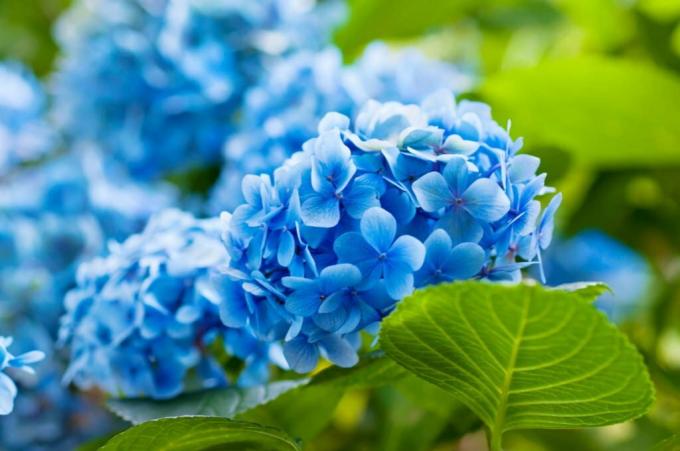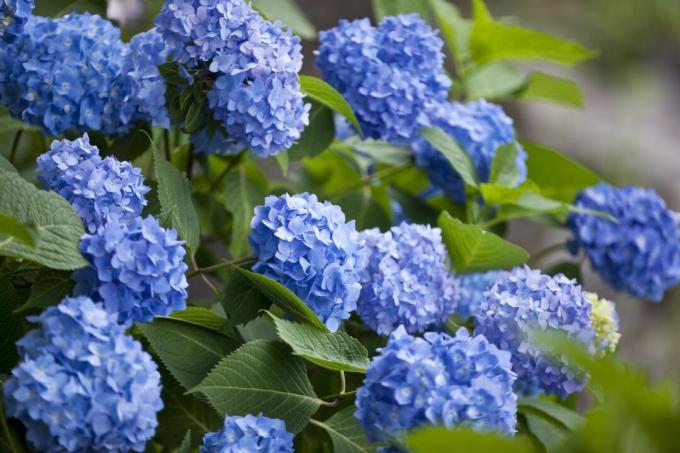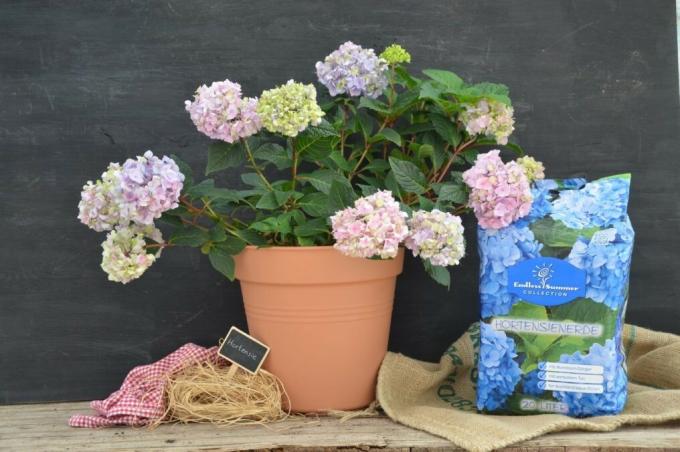Which fertilizer is suitable for blue hydrangeas? How to dye hydrangeas blue and keep the color Our tips for the correct handling of blue colored hydrangeas.

Farm hydrangeas (Hydrangea macrophylla) are special in terms of their flower color, because this does not only depend on the hydrangea variety, but also on the soil conditions. Garden hydrangeas and Plate hydrangeas of the kind H. macrophylla, which are summarized under the name of farm hydrangeas, bloom in pink, red, purple, white or blue. But blue and purple hydrangeas quickly lose their extravagant color and turn red or pink - we explain how you can avoid this.
contents
- What makes pink hydrangeas blue?
- Here's how to test the pH for blue hydrangeas
-
Coloring hydrangeas blue: instructions and the right fertilizer
- How to color pink hydrangeas blue
- Are there home remedies for coloring hydrangeas blue?
- This is how you can keep hydrangeas blue
In the following we show the conditions under which hydrangeas bloom blue and what the soil conditions have to do with it. You will also find instructions on how to color your hydrangeas blue yourself.
What makes pink hydrangeas blue?
The reason for the change in color of the hydrangea flowers of pink and red varieties is due to the flower color of the plant. The red or blue dye is called delphinidin and belongs to the anthocyanin group. This color molecule changes its structure with the help of metal ions (aluminum, iron) and forms so-called chelate complexes. These give the hydrangea flowers an intense blue color.
In order to color a hydrangea blue, the flower must ideally first be pink. If their color is too red, the combination with blue delphinidin results in a more violet hue. Since white hydrangeas do not contain any delphinidin at all, they cannot be colored blue.

Requirements for dyeing hydrangeas blue:
Hydrangeas need acidic soil. This is characterized by a pH value below 6. Hydrangeas preferably have a pH value around 4.5, they are optimally adapted to these acidic soil conditions. If the pH value is too high (> 4.5), the iron and iron that are important for the blue coloration are Aluminum ions are no longer readily available in the soil and are taken up by the hydrangea roots highly limited.
Another basic requirement for successful blue dyeing is that the plant to be colored is a hydrangea of the right species. In addition to white varieties of the species H. macrophylla let others Hydrangea species how Velvet hydrangeas (Hydrangea aspera ssp. sargentiana), Climbing hydrangeas (Hydrangea petiolaris) and Panicle hydrangeas (Hydrangea parniculata) do not turn blue either. This shade can only farm hydrangeas with violet and pink flower color.

Furthermore, the hydrangea must be healthy and sufficiently supplied with nutrients and water. To ensure a needs-based supply of nutrients, hydrangeas should be given a suitable fertilizer such as ours every year Plantura hydrangea fertilizer be fertilized.
Here's how to test the pH for blue hydrangeas
An acidic soil (soil pH <5) is one of the basic requirements for blue hydrangea flowers. How to Test Your Soil's pH:
- Put about 100 g of your soil in a mason jar.
- Add 100 ml (distilled) water and mix everything thoroughly.
- After 10 minutes you can dip a pH test strip into the solution and read the result on a color scale (you can get the pH paper in hardware stores or pharmacies, for example).
- However, the result obtained in this way is not exact: the actual pH value is about 0.5 points lower than indicated.
- You can obtain a more precise and faster measurement result with a special measuring device, a so-called soil pH meter.
If your pH value is above 5 according to the measurement, you should acidify it as described below in the article.
The lower the pH value, the more noticeable the blue color of the hydrangeas becomes:
- Weakly acidic soil (pH value around 5.5): The blue coloration no longer forms and the blue or purple hydrangeas turn pink or red again.
- Strongly acidic soil (pH value around 4): The blue hydrangeas keep their blue color, pink hydrangeas turn blue.
Coloring hydrangeas blue: instructions and the right fertilizer
In order to achieve the color change of the hydrangea flowers from pink to the popular hydrangea blue, two main steps are important. The first thing to do is to acidify the soil in which the hydrangea grows. A low pH value is the prerequisite for the uptake of aluminum and iron ions, which can be supplied secondly by adding alum dissolved in water. Finally, maintaining the soil's acidic pH is important to avoid discoloration.
How to color pink hydrangeas blue
- To lower the pH value directly when planting, you can either use special (in the Usually use peaty) hydrangea or rhododendron soil or your garden soil directly with peat Mix. Since hydrangeas and other bog bed plants can no longer efficiently absorb essential iron when the pH value is too high, this measure is necessary in any case in order to Iron deficiency in hydrangeas to prevent. The acidic pH makes the aluminum in the soil available and the hydrangeas turn blue.
- In order to achieve a faster and more intensive color change in the hydrangea flowers, aluminum can also be artificially added to the soil. More precisely, one uses potassium aluminum sulfate (alum) or aluminum sulfate. You can even get these aluminum compounds in pharmacies.
To make a blue color to begin with, water the hydrangea during the phase of the Drive out, or until the beginning of June, with a solution of three to four grams of alum in one Litre water. You should repeat this about four to five times with an interval of 7 days. - You can get "Blue Hydrangeas" from specialist garden shops. These agents lower the pH value for a short time and the aluminum turns the hydrangeas blue. "Hydrangea blue" unfortunately does not keep the flowers blue permanently, but acidifying the soil has a lasting effect. Please do not confuse the blue hydrangea with Blue grain. Blue grain is a universal fertilizer that got its name because of its own color.

Tip: When fertilizing with alum, always use rainwater or tap water acidified with peat to prevent the pH value from increasing through the hard, hard tap water.
Are there home remedies for coloring hydrangeas blue?
Those who want to do without it, tend to use environmentally harmful peat and hydrangea blue or alum buy, who can also try home remedies to turn the hydrangea flowers blue to evoke. Grape pomace (by-product of winemaking), the needles of conifers or acidic primary rock flour (basalt, granite) are suitable for lowering the pH value of the soil. Iron and aluminum ions are present in sufficient quantities in most natural soils and do not have to be supplied. With potted plants you should therefore mix in a good amount of garden soil to bring in iron and aluminum. The acid bog soil, of all things, which is present on former, drained bog areas, is an exception here - it is very poor in iron.
This is how you can keep hydrangeas blue
When planting or transplanting blue hydrangeas, the most important thing is choosing the right substrate. The pH value of the soil must then be kept permanently low in order to avoid discoloration. You can obtain acidic soil with a pH value of 4.5, among other things, by watering it Only use low-lime rainwater that has been acidified by peat, vinegar or bark mulch will.

In addition, you should regularly mulch with leaf compost, lawn clippings or needle litter, as the organic material releases acids into the soil, which have a pH-lowering effect. Regular use of grape marc and sour rock flour also helps to keep the soil acidic.
With a soil pH meter you can check the pH value of the substrate in order to be able to react in good time to an increase in pH value.
Tip: If other plants in the bed should not be disturbed by the low pH value, you can also grow your blue hydrangeas in the tub. The smaller soil volume there makes it easier to keep the soil acidic anyway. Alternatively, it is a good idea to create a “bog bed” in which only acid-tolerant plants grow. These include species such as the beautiful berry (Gaultheria procombens) or the Lavender heather (Pieris japonica) as well as numerous grasses and the beautiful Skimmie (Skimmia japonica).
Abstract coloring hydrangeas blue:
Two conditions must be met for your hydrangeas to turn a nice blue:
- Pink or red hydrangeas of the species only Hydrangea macrophylla can be turned blue or color dark purple.
- The soil must be acidic, i.e. the pH value must be around 4.5 and kept low: For this purpose, mulch regularly with acidic material and water with acidified rainwater.
- The blue color is easier to achieve in the bucket than in the garden soil due to the smaller volume of soil.
- Aluminum ions must be available in the substrate: The hydrangeas can do this with aluminum sulfate can be poured (alum solution or special fertilizer), but aluminum is usually found in natural soils before.
In addition to the right pH, there are other factors that make hydrangeas bloom beautifully. Everything you need to know about Caring for hydrangeas learn from this article.

